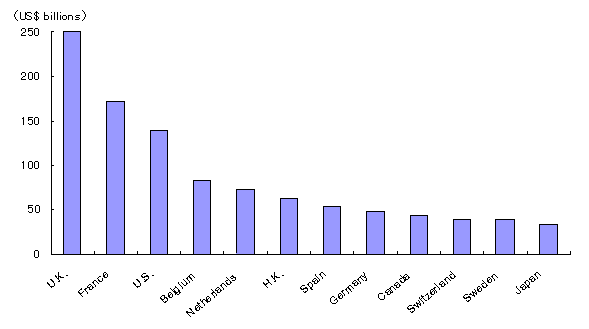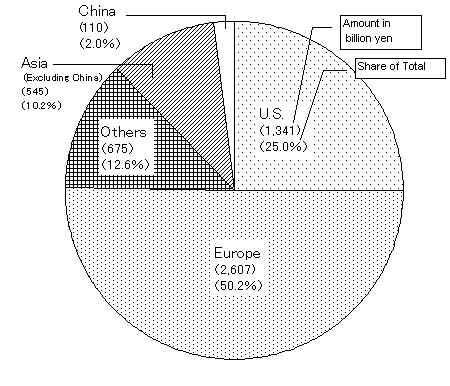The increase of Japanese investment in China has given rise to concern in Japan that its industry may "hollow out" as a result. However, economic theory suggests that foreign direct investment is a win-win game that benefits both the investing and the receiving countries, while empirical evidence shows that Japan invests too little, rather than too much, in foreign countries in general, and in China in particular.
Japan's FDI is certainly not large given the scale of its economy. According to the UN's World Investment Report , Japan's total direct investment overseas in 2000 was only $32.8 billion, or less than 1% of its GDP. This hardly compares with the United Kingdom, France and the US, which in that year made direct investment overseas to the tune of $249.8 billion $172.5 billion and $139.2 billion, respectively. In fact, Japan ranks a low twelfth behind Canada and Sweden ( figure 1 ). As viewed from this international comparison, Japan is not a large but rather a small source of global FDI. One must wonder what then is the big fuss being made over the hollowing out of Japan, when such talk is seldom heard in the countries that rank above Japan in FDI.
China has never been Japan's major destination to invest. The Ministry of Finance reports that Japanese investment in China in FY2000 was a meager 110 billion yen, constituting only 2% of Japan's overall FDI (amounting to 5.1 trillion yen), and 0.02% of Japan's GDP ( figure 2 ). This fell far behind Japan's direct investment in the US, which amounted to 1.3 trillion yen in the same year. According to statistics from the Ministry of Economy, Trade and Industry, total sales by overseas affiliates of Japanese companies in FY2000 were 58 trillion yen, of which 5 trillion yen, or 8.6%, was by affiliates in China. This lagged far behind sales by Japanese affiliates in the US, which amounted to 20.4 trillion yen.
Japan's investment in the US does not only far exceed that in China in monetary terms, but is moreover concentrated in Japan's key industry, the auto industry. Indeed, the theory of comparative advantage suggests that Japanese direct investment in China, which aims to utilize the latter's cheap labor, improves the allocation of resources, while Japanese direct investment in the US made to avoid trade friction could actually distort the optimal allocation of resources. If overseas investment were to take the blame for Japan's hollowing out problem, the true culprit should be US-bound investment, instead of China-bound investment.
It is also incorrect to assume that Japanese companies reduce their domestic production by the amount that their sales increase overseas. In practice, in addition to income earned from sales by their foreign affiliates in the form of dividends and licensing fees, many Japanese companies increase their exports of parts and components to support their overseas production.
These merits notwithstanding, the question remains as to whether direct investment in China usurps employment opportunities in Japan. In this regard, the US experience of the 1990s clearly showed that if macro-economic policy is appropriate and regulations that impede the flow of resources are relaxed, new industries would emerge, making it possible to maintain full employment while it was increasing overseas investment.
In the final analysis, Japan's "hollowing out syndrome" is neither based on a correct understanding of economic theory nor supported by empirical evidence. Rather, it reflects political considerations underscored by issues of income distribution among various types of industry, including the cost of industrial adjustment on one hand, and a general loss of confidence in the Japanese economy after protracted years of economic stagnation on the other. Instead of wasting time looking for scapegoats overseas for its domestic problems, Japan should concentrate on putting its house in order.
Figure 1:The world's major sources of FDI

Figure 2:Japanese foreign direct investment by region



